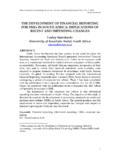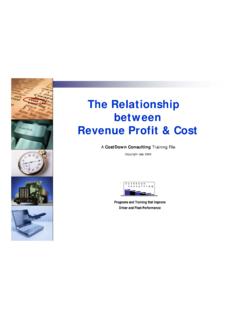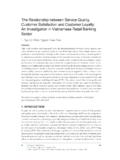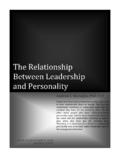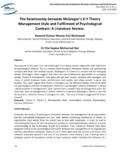Transcription of THE RELATIONSHIP BETWEEN EXCHANGE RATES …
1 North American Journal of Finance and Banking Research Vol. 4. No. 4. 2010. Gopalan Kutty 1 THE RELATIONSHIP BETWEEN EXCHANGE RATES AND STOCK PRICES: THE CASE OF MEXICO Gopalan Kutty1 Mansfield University, USA ABSTRACT This paper examines the RELATIONSHIP BETWEEN stock prices and EXCHANGE RATES in Mexico. The Granger causality test shows that stock prices lead EXCHANGE RATES in the short run, and there is no long run RELATIONSHIP BETWEEN these two variables. This finding corroborates the results of Bahmani-Oskooee and Sohrabian s (1992) conclusion, but contradicts the findings of other studies which reported a long term RELATIONSHIP BETWEEN EXCHANGE RATES and stock prices. Keywords: EXCHANGE RATES ; cointegration; stock prices JEL: C52, F31 _____ 1 Gopalan Kutty is a professor at the Department of Business & Economics Mansfield University, Mansfield, PA 16933, Telephone: 570-662-4516.
2 North American Journal of Finance and Banking Research Vol. 4. No. 4. 2010. Gopalan Kutty 2 I. INTRODUCTION Knowledge of the factors that influence the behavior of stock prices and EXCHANGE RATES has attracted the attention of economists, policy makers, and the investment community for a long time. This is especially noteworthy since 1973 when the many countries in the world adopted freely floating (or managed floating) rate systems. There has been a never ending debate with regard to the desirable degree of flexibility in the EXCHANGE rate objectives in determining the monetary policy of a country. Proponents of the freely floating EXCHANGE rate system argue that foreign EXCHANGE RATES should be determined by market forces. This argument is based on the assumption that in a perfect market, free of intervention by governments or monetary authorities, markets can allocate resources efficiently and determine nominal EXCHANGE RATES .
3 However, this is only achievable if markets are free of distortions. Whenever there are distortions like sticky prices, monetary authorities may target EXCHANGE RATES to correct current account deficits. Therefore, it is safe to say that EXCHANGE RATES are like prices of any other asset and are determined by expectations regarding future interest differentials BETWEEN courtiers, current account deficits, the external debt, terms of trade, interest rate differential , and economic and political conditions. It is also important to identify at this point the factors that influence the behavior of stock prices. Movements in the daily stock prices are influenced by Gross Domestic Product (GDP), employment, interest RATES , corporate performance EXCHANGE RATES , trade balance, inflation, money supply, productivity RATES and others.
4 Understanding the RELATIONSHIP BETWEEN EXCHANGE RATES and stock prices is important from the point of view of policy makers, and the investment community in this changing global environment. Currency is quite often included as an asset in the portfolio held by mutual funds, hedge funds and other professionally managed portfolios, and knowledge of the RELATIONSHIP BETWEEN EXCHANGE RATES and stock prices may enable the manger to manage risk efficiently. Furthermore, in the globally intertwined economy, in which there are little or few barriers to the flow of capital, has created investment opportunities for multinational corporations in developing and transition countries. This has, in turn created a need to understand the link BETWEEN EXCHANGE RATES and stock prices to hedge the portfolio risk.
5 A large body of literature examines the RELATIONSHIP BETWEEN stock prices and foreign EXCHANGE RATES in developed as well as developing countries. However, there is no settled opinion with regard to the RELATIONSHIP BETWEEN these variables. Controversy exists among economists and policy makers as to whether stock prices influence EXCHANGE RATES or vice versa. This controversy makes the study of EXCHANGE RATES and stock prices interesting and challenging. II. THE THEORY Economic theory postulates that interest RATES , inflation, price level, and money supply and other factors are important variables in understanding the behavior of stock prices and predicting the trends and movements in EXCHANGE RATES . Traditional economic models argue that changes in EXCHANGE RATES affect balance sheet items of a North American Journal of Finance and Banking Research Vol.
6 4. No. 4. 2010. Gopalan Kutty 3 firm through its competitiveness as expressed in foreign currency and ultimately, profits and equity. Branson and Masson (1977), Ghartey (1998), Meese and Rogoff (1983), and Wolff (1988) have found some RELATIONSHIP BETWEEN macroeconomic variables and EXCHANGE RATES . Furthermore, firms operating outside the sovereign boundaries of a nation face three different types of exposure, namely: operating exposure, transaction exposure, and translation exposure. Transaction exposure arises when international transactions denominated in a foreign currency are settled thereby resulting in gains and losses; translation exposure (also called accounting exposure) is the result of translating foreign currency denominated financial transaction into consolidated financial statements often expressed in the parent country s currency; economic exposure or operating exposure is the result of a change in the EXCHANGE RATES .
7 There are basically two theories that link EXCHANGE RATES and stock prices: The traditional approach argues that currency depreciation will result in higher exports and therefore corporate profits resulting in higher stock prices in the short run. The transmission mechanism according to this approach is the competitiveness of the firm s exports, resulting in changes in the value of the firm's assets and liabilities culminating in higher profits and reflecting its stock prices. This RELATIONSHIP is attributed to Solnick (1987). He argued that a real currency appreciation is a bad news for domestic corporation, because it will reduce its competitive ability to export, while a real depreciation enhances its ability to export in the short run. Another theoretical argument in the RELATIONSHIP BETWEEN stock prices and EXCHANGE RATES is the portfolio adjustment approach.
8 According to this theory, portfolio adjustments [movements in the foreign capital- inflows and outflows of foreign capital] occur whenever there is a change in the stock prices. If stock prices are on the increase, they will attract more foreign capital. However, a decline in the stock prices will result in diminished corporate wealth leading to the reduction in the country s wealth. This may lead to a fall in the demand for money and monetary authorities reduce the interest RATES to alleviate this situation. When interest RATES are lower (relatively speaking), capital may flow out of the country to take advantage of higher interest RATES in other part of the world resulting in currency depreciation. Therefore, according to this theory, lower stock prices may lead to currency depreciation. In examining the RELATIONSHIP BETWEEN stock prices and EXCHANGE RATES , we are confronted with the question regarding whether changes in the stock prices affect EXCHANGE RATES or vice versa.
9 We approach this question by using Granger (1969) causality tests. This model is quite simple and has been used extensively in applied economic research. Further, we make use of unit roots and cointegration tests to establish or refute the long-run RELATIONSHIP BETWEEN stock prices and EXCHANGE RATES . The paper is organized as follows: section three is devoted to literature review, the model is presented in section four, empirical evidence is presented in section five and finally concluding remarks are presented in section six. North American Journal of Finance and Banking Research Vol. 4. No. 4. 2010. Gopalan Kutty 4 III. LITERATURE REVIEW Several studies attempted to investigate the interaction BETWEEN stock prices and EXCHANGE RATES in the industrialized countries and emerging financial markets. However, the results of some of these studies are inconclusive.
10 A BVAR model was employed by Abdalla and Murinde (1997) to examine the stock price interaction with EXCHANGE RATES in four countries. They concluded that EXCHANGE RATES Granger cause stock prices to change in India, Pakistan and Korea. However, they did not find any RELATIONSHIP BETWEEN stock prices and EXCHANGE RATES in the Philippines. Sjaastad and Scacciavillani (1996) found that when commodities that are traded internationally, a change in any EXCHANGE rate will result a change in the prices of those commodities. Solnick (1987) reported a weak positive RELATIONSHIP BETWEEN changes in the stock returns and changes in the real EXCHANGE RATES . Giovannini and Jordan (1987) conclude that ex ante returns and EXCHANGE RATES tend to move together in the Chiang s (1991) study shows evidence that excess returns in the foreign EXCHANGE market are correlated with equity market returns.

